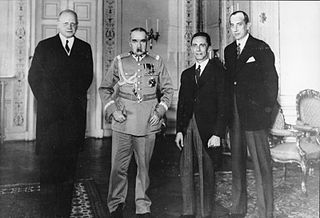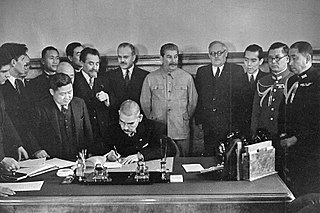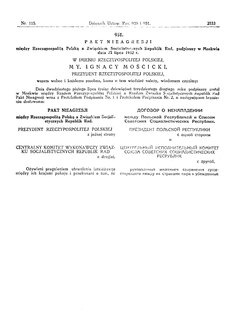 W
WThe Byzantine–Venetian treaty of 1268 was an agreement between the Byzantine Empire and the Republic of Venice that brought to a temporary end the hostilities between the two powers which had erupted after the Byzantine recovery of Constantinople by emperor Michael VIII Palaiologos in 1261.
 W
WGerman–Estonian Non-Aggression Pact was signed in Berlin on June 7, 1939, by the Estonian and German Ministers of Foreign Affairs Karl Selter and Joachim von Ribbentrop. German–Latvian Non-Aggression Pact was also signed on the same day. Ratifications of the German-Estonian pact were exchanged in Berlin on July 24, 1939 and it became effective on the same day. It was registered in League of Nations Treaty Series on August 12, 1939. The pact was intended for a period of ten years.
 W
WThe German–Latvian Non-Aggression Pact was signed in Berlin on June 7, 1939.
 W
WThe German–Polish Non-Aggression Pact was an international treaty between Nazi Germany and the Second Polish Republic that was signed on January 26, 1934. Both countries pledged to resolve their problems by bilateral negotiations and to forgo armed conflict for a period of 10 years. The pact effectively normalised relations between Poland and Germany, which had been strained by border disputes arising from the territorial settlement in the Treaty of Versailles. Germany effectively recognised Poland's borders and moved to end an economically-damaging customs war between the two countries that had taken place over the previous decade.
 W
WThe German–Turkish Treaty of Friendship was a non-aggression pact signed between Nazi Germany and Turkey on 18 June 1941 in Ankara by German ambassador to Turkey Franz von Papen and Turkish Minister of Foreign Affairs Şükrü Saracoğlu. It went into effect on the same day.
 W
WThe Greek–Romanian Non-Aggression and Arbitration Pact was a non-aggression pact signed between Greece and Romania on 21 March 1928. The pact effectively ended Greece's diplomatic isolation within the Balkan peninsula, strengthening its position on the negotiating table with Bulgaria, Yugoslavia and Turkey. Romania on the other hand gained a regional ally against its Slavic neighbors.
 W
WThe Molotov–Ribbentrop Pact was a non-aggression pact between Nazi Germany and the Soviet Union that enabled those two powers to partition Poland between them. The pact was signed in Moscow on 23 August 1939 by German Foreign Minister Joachim von Ribbentrop and Soviet Foreign Minister Vyacheslav Molotov and was officially known as the Treaty of Non-Aggression between Germany and the Union of Soviet Socialist Republics.
 W
WThe Sino-Soviet Non-Aggression Pact was signed in Nanjing on August 21, 1937, between the Republic of China and the Soviet Union during the Second Sino-Japanese War. It went into effect on the day it was signed. It was registered in League of Nations Treaty Series on September 8, 1937.
 W
WThe Soviet–Finnish Non-Aggression Pact was a non-aggression treaty signed in 1932 by representatives of Finland and the Soviet Union. The pact was unilaterally renounced by the Soviet Union in 1939 after having committed a deception operation in Mainila in which it shelled its own village and blamed Finland.
 W
WThe Soviet–Japanese Neutrality Pact , also known as the Japanese–Soviet Non-aggression Pact , was a neutrality pact between the Soviet Union and Japan signed on April 13, 1941, two years after the conclusion of the Soviet-Japanese Border War. The agreement meant that for most of World War II, the two nations fought against each other's allies but not each other. In 1945, late in the war, the Soviets scrapped the pact and joined the war against Japan.
 W
WThe Soviet–Polish Non-Aggression Pact was a non-aggression pact signed in 1932 by representatives of Poland and the Soviet Union. The pact was unilaterally broken by the Soviet Union on September 17, 1939, during the Soviet invasion of Poland.
 W
WThe Soviet–French Non–Aggression Pact was a treaty concluded on November 29, 1932 between the Soviet Union and France. The agreement was preceded by lengthy negotiations, which began back in 1928.
 W
WThe Treaty of London in 1518 was a non-aggression pact between the major European nations. The signatories were Burgundy, France, England, the Holy Roman Empire, the Netherlands, the Papal States and Spain, all of whom agreed not to attack one another and to come to the aid of any that were under attack.